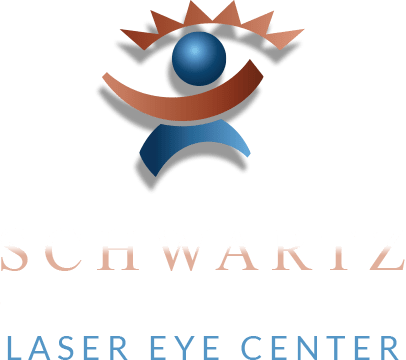According to the National Institutes of Health, cataracts affect more than half of all Americans over the age of 80, and are very common in people over the age of 50. However, despite the prevalence of this condition, many people aren’t exactly sure what cataracts are, which can make them difficult to recognize in the early stages. Here we provide a brief overview of cataracts, the different types and the symptoms that accompany them, and some of the intraocular lenses we have to treat them. To learn more about cataracts from Dr. Schwartz, contact our Scottsdale, Glendale or Mesa eye care center today.
What Are Cataracts?
Much like how clouds are formed by water molecules, cataracts occur when proteins within the liquid inside the lens of the eye begin to break down and stick together. This cloudy area within the eye accumulates proteins over time, making the cataract grow and muddying a person’s vision.
Since this condition happens within the lens of the eye, it can affect just one eye or both. Typically, especially in cases of cataracts forming in both eyes, the cause is age. However, cataracts can be created by outside factors as well — for instance, certain medications, physical damage to the eye, lifestyle choices, and environmental influences can all play a role in the creation of a cataract.
Conditions and Symptoms
There are different kinds of cataracts, and the symptoms for each differ slightly. Naturally, all cataracts result in obstruction of vision from within the eye itself, but knowing the different symptoms can help determine what kind of cataract is present, and in turn, how to properly treat the cataract. All types of cataracts are treated at our Scottsdale eye care center, and are explained in general below:
Nuclear – This is the most common type of cataract. It occurs in the middle of the lens (also known as the central nucleus). This is a slow growing cataract that affects distance vision, lending a yellow tint to the nucleus itself.
Subcapsular – These progress quickly and become advanced within months. Subcapsular cataracts occur within the back of the lens and cause blurriness and glare in vision. Retinitus pigmentosa, advanced nearsightedness, diabetes, and steroid medication can all help create this type of cataract.
Cortical – This type of cataract starts at the outermost part of the lens, then advances towards the center of the lens, creating a starburst pattern. This causes problems for both distance and near vision because it occurs within the lens cortex, and can cause halos to appear around lights. It is also the most common form of cataract affecting the elderly.
Congenital – These are cataracts that have existed since birth, and any of the three listed above can be included. There are a few different reasons why they may exist, including infection in-vitro or some genetic conditions. These cataracts do not always affect vision, but if they do, diagnosing this issue early can play a key role to a child’s development. If you are concerned, please feel free to contact us and make an appointment.
Treatments and IOLs (Intraocular Lenses)
A range of treatment options can be called upon to treat cataracts, from eye glasses to the surgical placement of intraocular lenses. The treatment that is appropriate for you will be determined during your initial consultation with Dr. Schwartz. Here are some of the lenses we offer at Schwartz Laser Eye Center located in Glendale, Mesa, and Scottsdale, Arizona:
AcrySof IQ PanOptix® intraocular lenses are the first IOLs to offer trifocal vision, providing clear focus at near, intermediate and far distances. Dr. Schwartz is among the first ophthalmologists in the state to make this advanced option available to cataract surgery patients. Although new to the American market, PanOptix has established a solid track record around the world, with a documented satisfaction rate of 99 percent. PanOptix creates such impressive outcomes by splitting light into three focal points: The intermediate focal point for these remarkable lenses is 60 cm, which is within the optimal range established by the U.S. Occupational Safety and Health Administration for performing tasks using digital screens. This is more practical than the 80 cm focal point used by some other lenses. The near vision focal point is 40 cm, an ideal distance for reading and other close-range tasks. The third focal point is infinity, allowing clear, panoramic views of the world around you. According to the PanOptix FDA registration study, 20/20 vision or better is a likely outcome at near, far and intermediate distances for most patients.
AcrySof ReSTOR® IOL is recommended for cataract patients requiring vision correction at varying distances. Individuals who need bifocals or eyeglasses to read up-close and to see at a distance are typically good candidates for the AcrySof ReSTOR® IOL. This innovative lens is implanted into the eye and provides superior results, which are typically evident just one day after the procedure. The lens material is soft and pliable, so lenses can be easily implanted and are also comfortable.
TECNIS® – This implantable lens provides patients with exceptionally clear, crisp vision at varying distances, in any type of lighting. Patients most likely won’t need to wear glasses or contact lenses after the procedure.
Crystalens® AO Accommodating Lens – This lens actually uses the focusing muscles within the eye to provide a more natural range of vision change. So whether it’s going from reading to looking out the window, the transition feels more like it should. The lens also helps with night vision, reducing glare that is normally found in other IOLs.
Victus Femtosecond Laser
We use the Victus femtosecond laser to help enhance the safety and precision of cataract surgery. The femtosecond laser replaces traditional surgical instruments in key steps of the procedure, including the creation of the incision in the capsule holding the lens, and the softening and fragmentation of the lens. The laser is specifically calibrated based on the individual patient’s eye anatomy for better accuracy. Also, replacing a handheld instrument with a laser eliminates many of the risks associated with traditional cataract surgery.
Surgical Procedure
Surgery to remove a cataract and replace it with an artificial intraocular lens (IOL) will typically take less than a half hour, although you should plan to be at our facility for two to three hours overall. Before the procedure, experienced ophthalmologist Dr. Jay Schwartz or Dr. Orry Birdsong will take detailed measurements of your eyes to ensure your new IOLs will be a perfect fit. This will include custom corneal mapping (also known as corneal topography) and macular OCT imaging. Dr. Schwartz or Dr. Birdsong will operate on one eye during the outpatient procedure; surgery for the second eye will take place one to four weeks later, if appropriate.
Depending on your preferences, you may receive a sedative in addition to the standard local anesthetic delivered via eye drops. A device will be put in place to prevent blinking, allowing your surgeon unobstructed access to the eye. During the surgery Dr. Schwartz or Dr. Birdsong makes a small incision in the cornea through which the clouded lens is broken up using a needle-thin ultrasound probe, the resulting debris is suctioned out, and the IOL is inserted. The experience is virtually painless; most patients report feeling only momentary pressure on the eye. You may require self-sealing sutures for the incision.
Recovery
When the procedure is complete, you will be given special eye drops to decrease inflammation and protect against infection. At home, you will need to wear a protective shield when you sleep, and also avoid sleeping on the same side as your healing eye.
In a few days, your vision should be clear enough to allow you to resume daily activities, including driving. You may notice some temporary sensitivity to bright lights. For the first week you will need to avoid anything beyond light physical activity, especially bending and lifting of heavy objects. Women should avoid makeup during this period. When showering, care should be taken to avoid soap or shampoo in the eyes. Vigorous sports and swimming should be avoided for a month, as should rubbing the eyes for as long as your eyes are healing. Because your eyes are operated on separately, with a one- to four-week interval, this habit should be avoided for at least three to six months.
During the recovery period, it is important that you keep your follow-up appointments with Dr. Schwartz or Dr. Birdsong. They will monitor your progress regularly, beginning the day after surgery. This helps them determine when cataract surgery can be scheduled for the second eye, assuming this eye has also developed a cataract, and to check for potential complications, including infection, excessive inflammation, hemorrhaging and retinal detachment. If at any time during your recovery you experience pain, headache, nausea or a worsening of vision, call the office immediately. This may indicate a medical emergency, and will require immediate evaluation.
The good news is that serious complications with cataract surgery are extremely rare. This is especially impressive given the fact that cataract procedures are among the most common surgeries in the world. More than 20 million are performed worldwide each year, including nearly 4 million in the U.S. And once you have removed your cataracts, you will never need to repeat the procedure. With the clear, resilient IOL in place, your natural lens will not grow back.
If you would like to learn more about causes and treatment of cataracts, schedule a personal consultation with one of our experienced ophthalmologists Dr. Jay Schwartz or Dr. Orry Birdsong at our Glendale, Scottsdale and Mesa office by calling or emailing Schwartz Laser Eye Center today.
Learn More about Cataracts and Our Treatments
Think cataracts might be affecting you? Contact our office in Scottsdale or Glendale to schedule an appointment with Dr. Schwartz or Dr. Birdsong. We will gladly help you with any vision issues you may have, from cataracts, to macular degeneration, to myopia and hyperopia. After performing over 50,000 LASIK surgeries, Dr. Schwartz and Dr. Birdsong can safely be called one of the most trusted eye surgeons in the valley — come find out why for yourself!



